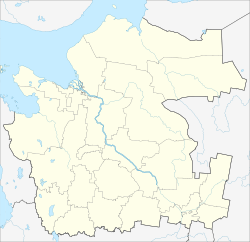Severodvinsk
| Severodvinsk (English) Северодвинск (Russian) |
|
|---|---|
| - City - | |
 Lomonosova Street in Severodvinsk |
|
 Location of Arkhangelsk Oblast in Russia |
|
|
|
|
|
|
|
|
|
|
| Anthem | Anthem of Severodvinsk |
| City Day | Last Sunday of July |
| Administrative status (as of June 2013) | |
| Country | Russia |
| Federal subject | Arkhangelsk Oblast |
| Administratively subordinated to | city of oblast significance of Severodvinsk |
| Administrative center of | city of oblast significance of Severodvinsk |
| Municipal status (as of April 2014) | |
| Urban okrug | Severodvinsk Urban Okrug |
| Administrative center of | Severodvinsk Urban Okrug |
| Mayor | Mikhail Gmyrin |
| Representative body | City Council of Deputies |
| Statistics | |
| Population (2010 Census) | 192,353 inhabitants |
| - Rank in 2010 | 95th |
| Time zone | MSK (UTC+03:00) |
| Founded | 1936 |
| Previous names |
Sudostroy (until 1938), Molotovsk (until 1957) |
| Postal code(s) | 164500–164502, 164504, 164505, 164507, 164509, 164510, 164512, 164514, 164515, 164518, 164520–164524, 164529 |
| Dialing code(s) | +7 81842 |
|
|
|
| on | |
Severodvinsk (Russian: Северодвинск; IPA: [sʲɪvʲɪrɐdˈvʲinsk]) is a city in the north of Arkhangelsk Oblast, Russia, located in the delta of the Northern Dvina River, 35 kilometers (22 mi) west of Arkhangelsk, the administrative center of the oblast. As of the 2010 Census, the population was 192,353. Due to the presence of important military shipyards (specialised in submarines since the Soviet period), Severodvinsk is an access restricted town for foreign citizens. A special pass is required.
The territories around the North Dvina were discovered at the start of the first millennium by Vikings. British and Norman ships came to these places for mining, fur and fishing before the 13th century, but later the climate became colder and access to the northern seas became closed.
The settlement on the site of modern Severodvinsk was first mentioned in 1419, when the Swedes sailed into the bay and burnt down the Nikolo-Korelsky Monastery that stood by the shore. This monastery is believed to have been founded by St. Euphemius, an Orthodox missionary in Karelia. The abbey stood in ruins until 1471, when two sons of Marfa Boretskaya died in a vicious storm; their bodies were recovered on the beach near the monastery twelve days later. At the urging of Boretskaya, the monastery was restored and her sons were buried there.
On August 24, 1553, a ship of Richard Chancellor reached the salt-mining settlement of Nyonoksa, which is still famous for its traditional wooden architecture. The British sailors visited the Nikolo-Korelsky Monastery, where they were surprised to find a community of "sailors in soutanes (cassocks)" and a pier large enough to accommodate several ships. The main church of this extraordinary establishment was dedicated to Saint Nicholas, the holy patron of sailors; hence, the whole White Sea became known in 16th-century English maps as "St. Nicholas Bay". In late 1613, during the Time of Troubles, Severodvinsk with the monastery was captured and looted by Polish-Lithuanian vagabonds, the Lisowczycy.
...
Wikipedia


